Raspberry Almond Layer Cake With Caramelised White Chocolate
A very good birthday (or any celebration) cake
July in my family has always been defined by birthdays and berries. Birthdays, because three out of five of my immediate family members celebrate theirs within two weeks of each other, and berries, because when I was small, my grandmother’s garden had a pathway lined with wonderfully wild raspberry bushes that would ripen each July. When the bushes hung heavy with juicy, ruby-hued fruit, we would walk over with repurposed yogurt containers and pick until our arms were scratched from the brambles, our fingertips were stained a deep red, and our containers and bellies were full.
The freshly picked berries inevitably found their way into our birthday cakes and today, I’m sharing the recipe for a cake heavily inspired by one my mother made countless times throughout my childhood. The combination of sweet cream, raspberries, and toasted almonds she used will forever be a nostalgic journey back to those summers.
This cake is intended for celebrations and sharing with those you hold dear. In all honesty, it is a labour of love that requires time and patience, but it is a worthy project and can be made easier by planning ahead and giving yourself plenty of time to enjoy the process. If you have the foresight, many of its elements can be made in advance: the buttercream, jam, cake soak, and almond mousse can be made up to four days ahead of time, just bring the buttercream and mousse to room temperature and rewhip before assembling. This cake improves with time and is best on the second day once the flavours have melded. Assemble and let it hang out in the fridge for a day before the big event, this will give you some breathing room to enjoy the moment.
Some of the elements can be simplified or avoided entirely if they feel intimidating: replace the raspberry compote with a nice store-bought raspberry jam, purchase caramelized white chocolate couvertures or use standard white chocolate in its place (or none at all!). This is meant to be an enjoyable project, not a stressful one. You know your limits.
Troubleshooting and tips for each step to help ensure that your cake is everything you hoped for follow the recipe. For best results, I recommend reading through them before starting.
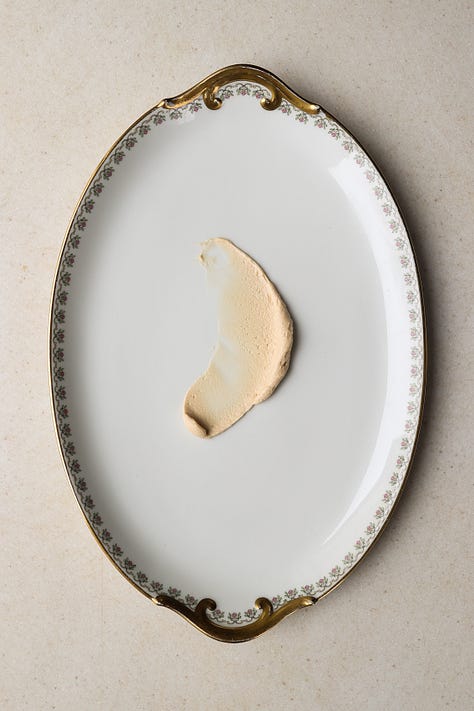



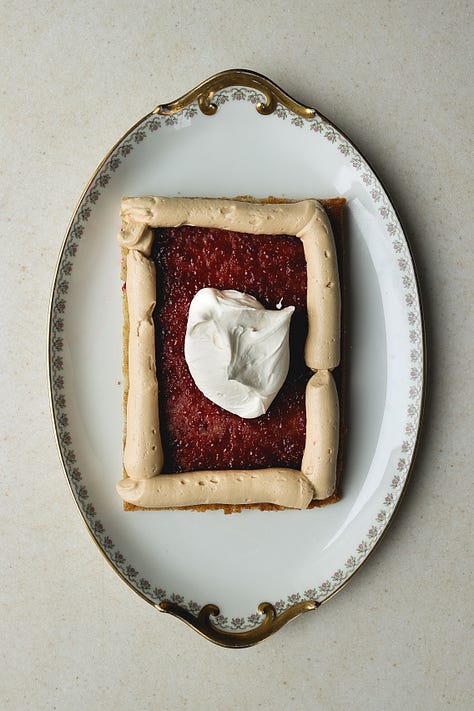
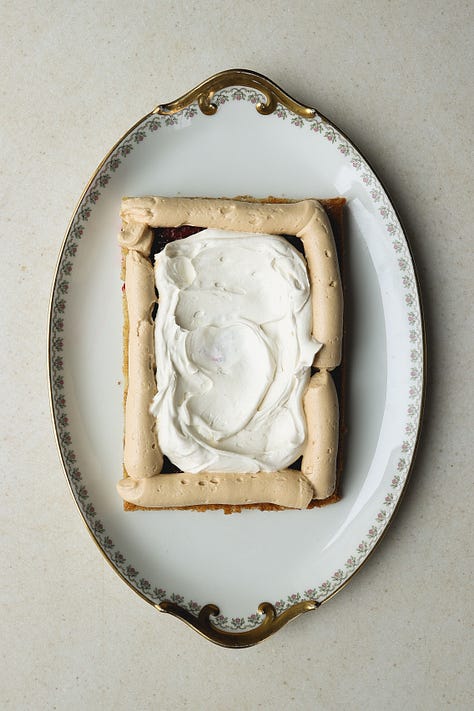
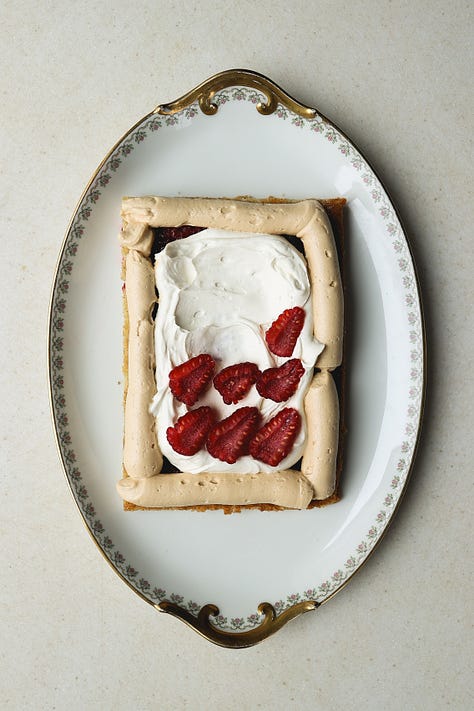
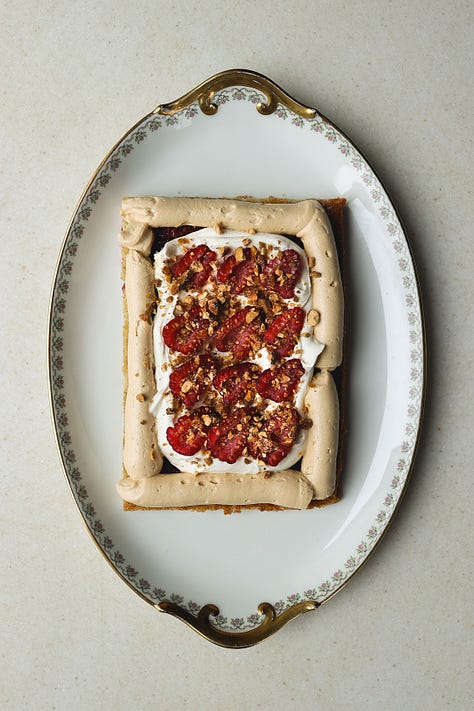
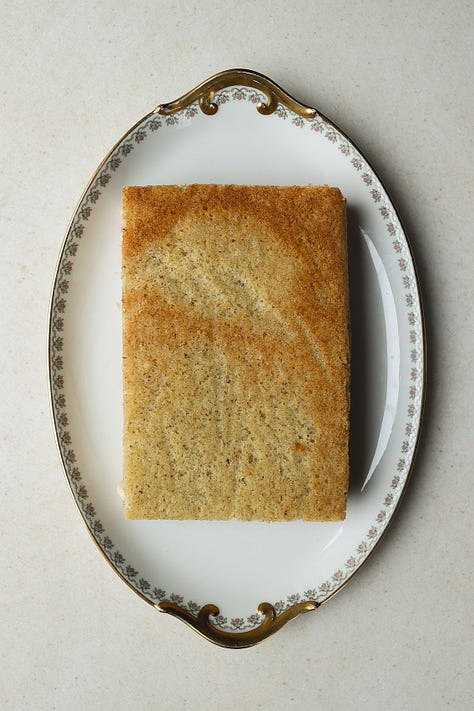
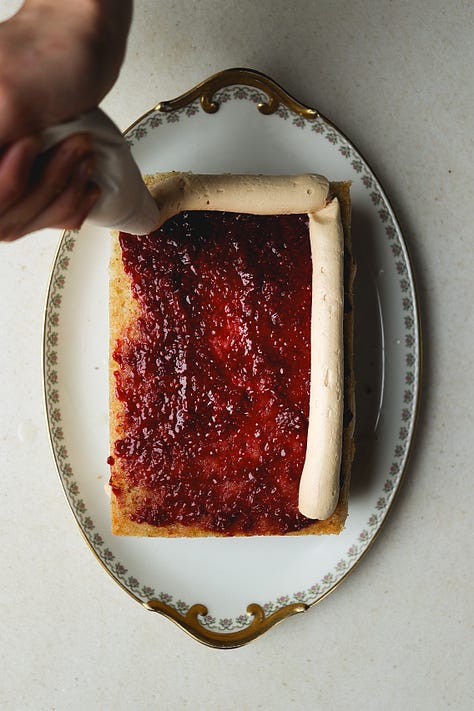
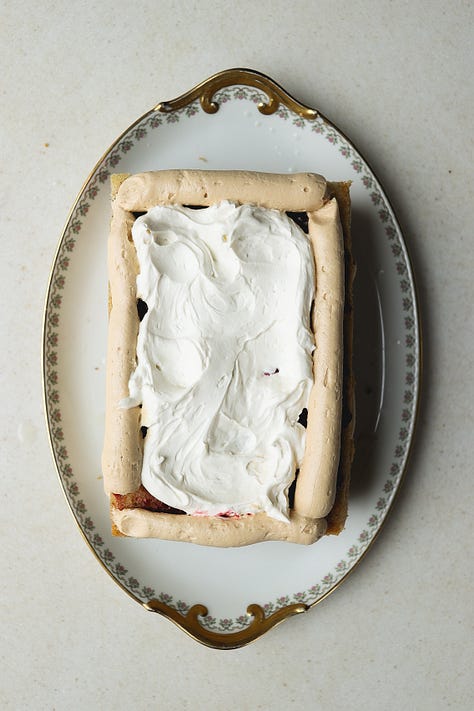

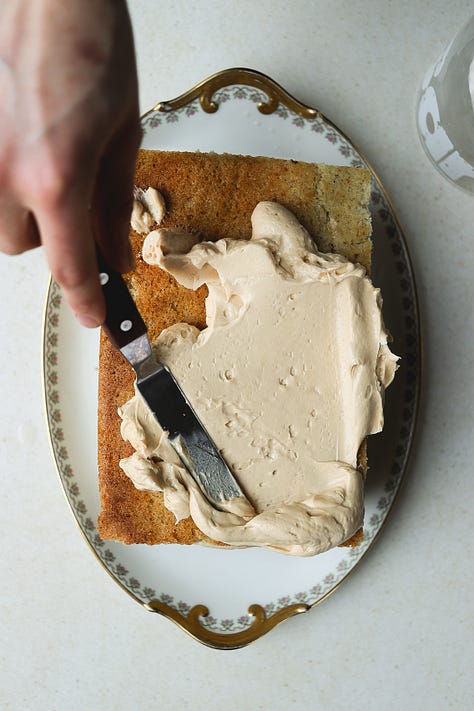
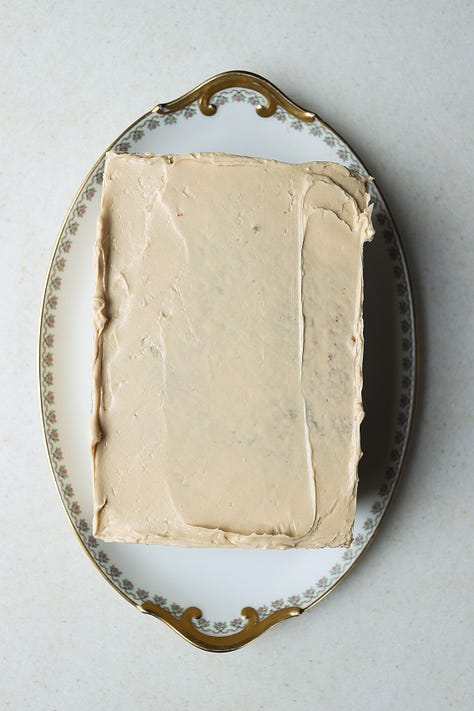
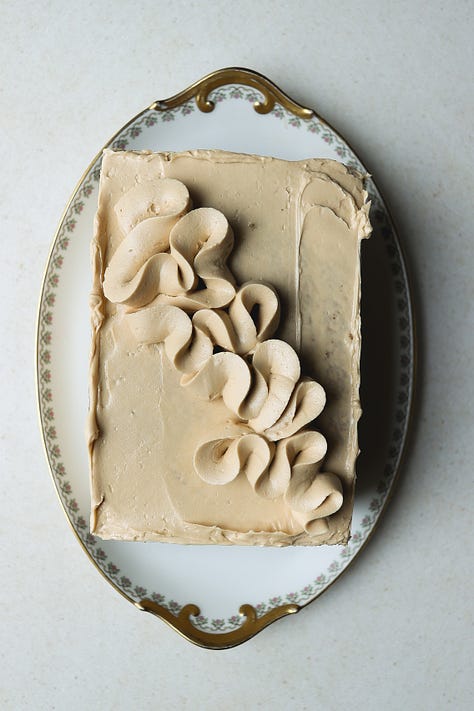
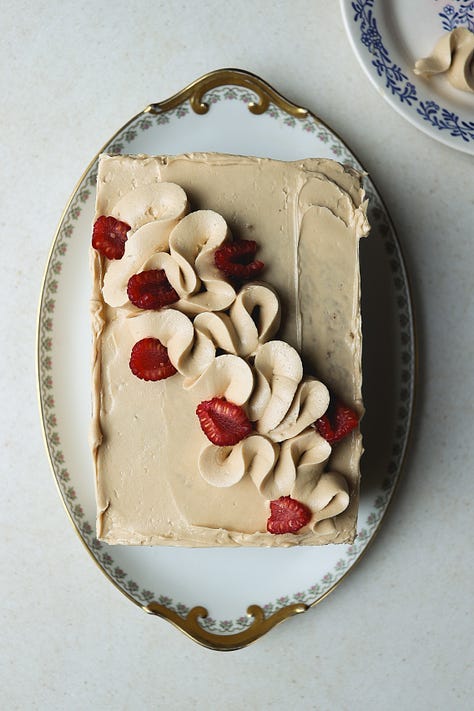
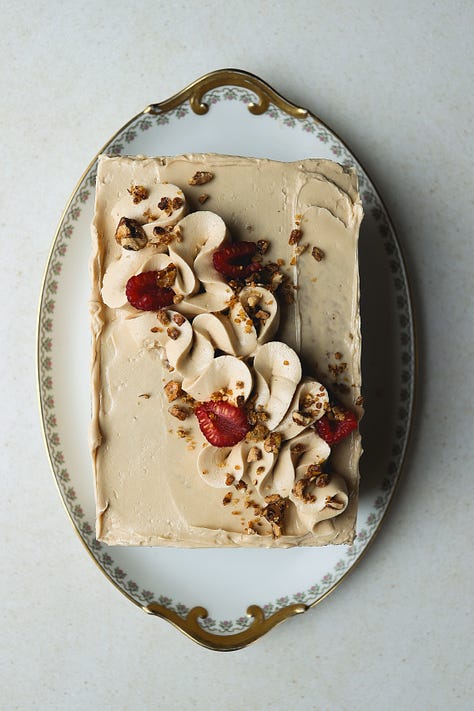
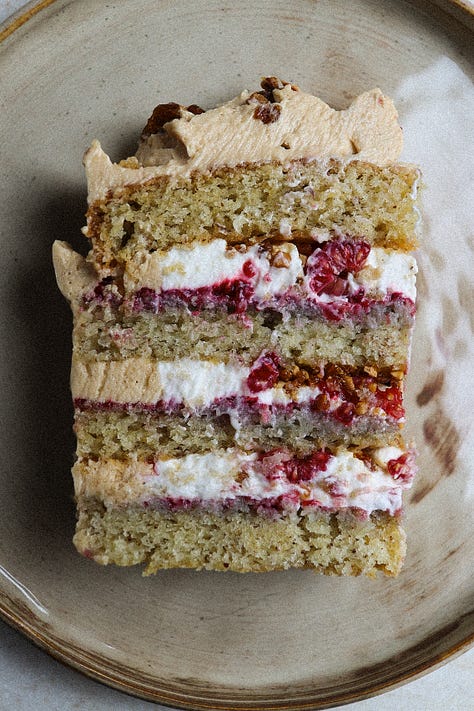
For the almond cake:
290g all-purpose (plain) flour
87g almond meal
2 tsp baking powder
3/4 tsp baking soda
1 1/2 tsp kosher salt
187g (203mL) neutral oil, like vegetable or grape seed oil
275g white sugar
2 large eggs
100g (100mL) buttermilk (or unsweetened plant-based milk + 1 tbsp apple cider vinegar)
Grease and line a half-sheet pan 46x33cm (18x13”) with parchment paper and preheat the oven to 180°C/350°F with a rack in the centre of the oven.
In a large bowl, whisk together the flour, almond meal, baking powder, baking soda, and salt.
In a second bowl, whisk together the oil and sugar. Then, whisk in the eggs, one at a time, until emulsified. Finally, whisk in the milk until homogeneous.
Add half of the dry ingredients to the wet and whisk to combine. Add the remaining half and switch to a spatula, stirring until just barely combined and being careful not to over mix.
Transfer the batter to your prepared pan and bake for 13-16 minutes, until evenly browned and a knife inserted into the centre comes out clean. Let the cake cool in the tray for 20 minutes, then invert onto a large cutting board or other surface and peel away the parchment paper to cool completely.
For the caramelised white chocolate Swiss meringue buttercream (SMBC):
200g white chocolate
8 large egg whites
400g white sugar
340g unsalted butter, cubed and room temperature
1 tsp almond extract
1 tbsp apple cider vinegar
1/2 tsp salt
Caramelise the white chocolate by placing it on a tray in the oven at 215°F/100°C. Stir every 10 minutes or so for about an hour until nicely browned and fragrant. It will loosen up as it caramelises so don’t stress if it seems to be firm or gritty initially. If it still has some lumps or ceases up after fully caramelised, blend it until silky. Set aside to cool. If made in advance, warm the chocolate slightly until spreadable (but not hot!) before adding to your buttercream.
Make the SMBC by whisking the egg whites and sugar together in a heatproof bowl set over a saucepan with an inch of simmering water. Whisk until the sugar is completely dissolved.
Transfer the egg-sugar mixture to the bowl of a stand mixer fitted with the whisk attachment and whisk on the highest setting until stiff peaks form. Before proceeding, make sure the meringue is at room temperature. You can speed the cooling up by placing the bowl in the refrigerator for 15-20 minutes.
Once the meringue is at room temperature, switch to the paddle attachment and with the mixer on medium speed, beat in the butter, one cube at a time, until the mixture is stable and silky smooth, then beat in the cooled caramelised white chocolate, almond extract, apple cider vinegar, and salt and set aside. This SMBC can be stored in the fridge for up to 5 days - before using, bring it to room temperature, then re-whip with the paddle attachment until fluffy and silky again.
Transfer the whipped buttercream to a piping bag fitted with a large round tip (or use a sturdy ziplock bag and cut a 1/2cm wide hole in the corner).
For the almond cake soak:
160mL whole milk/plant-based milk
1 tsp almond extract
1/8 tsp salt
1 1/2 tbsp white sugar
Bring all ingredients to a simmer in a small saucepan and stir until the sugar is dissolved, set aside.
For the almond mousse:
500mL 35% (double) cream
50g white sugar
1/8 tsp salt
30g well-roasted almonds, roughly chopped
2 sheets gelatine (or 1 tsp powdered gelatine)
Add the cream, sugar, salt, and roasted almonds to a saucepan and bring to a gentle simmer. Once the sugar is dissolved, remove from the heat and let the almonds steep in the cream for at least an hour or up to overnight, then strain through a fine sieve.
Soak the sheets of gelatine in cold water for a few minutes and bring the steeped cream to a simmer again in a clean saucepan. Drain the sheets of gelatine, then add them to the simmering cream and whisk until fully dissolved.
Strain the mixture through a fine sieve once more, then transfer to a container and chill in the refrigerator to set.
Right before using, whip the cream with the whisk attachment until fluffy like whipped cream, 2-3 minutes.
For the raspberry compote:
200g raspberries (fresh or frozen)
67g white sugar
1/4 tsp salt
Add all of the ingredients to a saucepan and simmer over medium-low heat, stirring often, until thickened, about 6-8 minutes. Store in the fridge until ready to use.
For assembly:
400g (1 1/2 pints) fresh raspberries, halved lengthwise
50g roasted almonds, finely chopped
Once fully cooled, use a serrated knife to cut your cake in half lengthwise, and then again crosswise to get four smaller rectangular layers (if you prefer a round cake, follow Natasha Pickowicz’s instructions for cutting out rounds from a sheet cake).
Spread a spoonful of buttercream on the bottom of a serving plate, cake stand, or cake card, then place a cake layer directly on top, centred on your base.
Use a pastry brush to brush cake soak evenly across the layer, then spread 1/3 of the raspberry compote directly overtop, right up to the edges.
Pipe Swiss meringue buttercream along the border, then fill in the centre with almond mousse. Cover the mousse with raspberries, followed by chopped almonds, then cover with another layer of cake. Repeat twice more with layers 2 and 3, then place the final layer of cake on top.
Cover your cake with a crumb coat by dolloping a generous amount of buttercream on top of the cake and using an offset spatula to spread it evenly across the top and around the sides. Remove any excess buttercream so that only a thin layer is coating the cake, then freeze for about 10 minutes to firm it up.
Remove the cake from the freezer and once more, dollop a generous amount of buttercream on top. Spread it across the top and down around the sides, smoothing the sides out with your offset spatula before decorating as you wish with decorative piping or swooshes of buttercream and more berries and almonds. Store the cake in the fridge until an hour before serving.
-Cake: The more you mix wheat flour and water (which is present in the milk and egg), the more gluten will develop and the chewier (and less tender) your cake will be. Mix the cake batter until combined and no more, then bake. Baking in a sheet tray prevents the cake from doming and yields thin layers for a nice ratio of cake:filling. This cake has a very tender crumb, handle it gently as you layer the cake.
-Caramelised white chocolate: be patient, caramelising white chocolate takes a little while but you must keep the oven at a low temperature and stir it with a spatula every 10 minutes or so. The chocolate will melt and be a bit grainy initially but eventually it will loosen up into a silky paste. If your chocolate is nicely browned and tastes like caramel but is still a bit lumpy/grainy or if it ceases up, transfer it to a blender and blend until smooth and silky, scraping down the sides as necessary.
-For the Swiss meringue buttercream: make sure when you separate your eggs that none of the yolk gets into the whites and whip them in a clean bowl. Any fat from the yolks will interfere with the protein in the whites forming a stable network that traps air, resulting in a soupy (instead of stiff) meringue.
-When making the meringue base for your SMBC, ensure that the sugar is completely dissolved before whipping. You can check this by rubbing a bit of the egg white-sugar mixture between two fingertips: if you feel any gritty sugar, it isn’t ready.
-Before adding butter to your whipped egg whites, they must be at room temperature or the butter will melt upon contact and the mixture will become soupy. If this happens, let the mixture sit at room temperature until it cools down and then beat it again (you can place it in the fridge for a few minutes to speed this up).
-The opposite can also happen: if the mixture is too cold when you add your butter, it might become gritty/lumpy instead of silky. To resolve this, warm a large spoonful of the SMBC in the microwave or on the stove, then slowly pour it into the mixer bowl on low speed and beat for 1-2 minutes. This should seed some warmth into the batch and bring it up in temperature. If it is still grainy, repeat with another scoop until smooth and silky.
-Make the SMBC up to 4 days in advance. Store it in the fridge and before using, leave it at room temperature for at least 3 hours. Whip in a stand mixer until silky again, seeding with a scoop of it warmed up if necessary to bring it back to a smooth, glossy, silky texture.
-For the almond mousse, make sure that you use well-roasted almonds that are nicely browned throughout for maximal nutty flavour. This can be made several days in advance and left to set, then whipped upon using.
-Sheet gelatine is my preference as you avoid the chance of any clumps of undissolved gelatine ending up in your final product. If you can’t find any, 1 tsp of powdered gelatine can also be used here, just sprinkle it into a small amount of cold cream while whisking to dissolve and letting it set for a couple of minutes before adding it into the warmed cream in the saucepan.
-Always serve your cake at room temperature! Softened buttercream tastes completely different than fridge-cold, hard buttercream and the overall experience will be much better.








Sounds delightful. Love the story!
This sounds so good and I love how it connects to cherished summers past. And I very much appreciate the encouragement to keep this an enjoyable project and not a stressful one! Excited to give it a go!